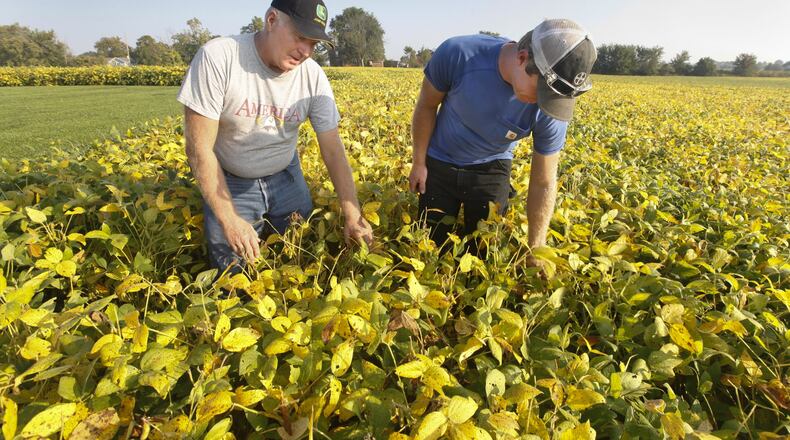“It’s definitely going to be of help, but we’re not back to where we were,” said Dale Seim, a Perry Twp. farmer who saw values across his parcels reduced 17 to 24 percent.
RELATED: Southern suburban residents file most property value complaints
Seim said he had been taxed at about $50 an acre, only to see them shoot up in recent years to $150 an acre on land where he raises corn and soybeans with his son, Scott.
“It made it very hard,” said Seim, the fourth generation Seim to run the farm. “It created a lot of hardships.”
A ‘perfect storm’
The formula — which takes into account soil types, yields, commodity prices, interest rates and other factors — was put in place in 1973 to tax farmland differently in order to preserve it, said Joe Cornely, Ohio Farm Bureau spokesman.
“You could make more money off your ground if you sold your farm ground to a developer and they put in housing tracts and strip malls, than if you just raised corn and soybeans on it,” he said. “We needed to have a special taxation system that taxes farm ground at its production capacity value as opposed to its development value.”
RELATED: Ohio farmers nervous over NAFTA changes
The system seemed to work for decades until about 2011, Cornely said. Then, a global shortage of commodities sent prices sky-high while interest rates — a large factor in the formula — were kept at record lows by the Federal Reserve to pull the country out of the Great Recession.
“This perfect storm started to form,” he said. “All of these factors added together were rapidly increasing the value of farmland.”
Farmers ‘took it on the chin’
Ohio farmers were yielding solid returns due to the high commodity prices and high production, but as land values soared, market forces shifted and crop prices plummeted in half. Tax bills came due.
Statewide, property taxes on farmers went up 307 percent between 2008 and 2014, according to the Ohio Farm Bureau.
RELATED: Thousands may be getting tax breaks they don’t deserve
Farmers took their case to the Ohio Department of Taxation and state legislature and were successful getting aspects of the formula modified. The changes were included in the state budget bill signed in June by Gov. John Kasich.
Slightly more than a third of Montgomery County’s 300,000 acres is in the CAUV program, according to the Montgomery County Auditor’s Office.
The median value of Montgomery County farmland more than doubled during the last full reappraisal in 2014 to $3,207 an acre. The 24 percent average decline this year won’t bring agricultural land values anywhere close to past levels, but is still good news for farmers, Keith said.
“They felt like they really took it on the chin in 2011 and 2014,” said Montgomery County Auditor Karl Keith. “I don’t know that they are going to see relief to the level that gets them back to where they were before ’11 or ’14, but they are going to see some relief as a result of this.”
RELATED: Farmers fear large tax bite
The decline in agricultural values comes after an update of commercial and residential property values showed an increase of 4.5 percent. The auditor’s office calculated $3.95 million in additional revenue on unvoted millage using the new commercial and residential values along with 2016 CAUV numbers. After calculating with the new CAUV and agricultural values, the additional new revenue expected dropped slightly to $3.7 million.
Seim, who is also the Perry Twp. Board of Trustees president, said the township isn’t likely to see much of a fluctuation in tax receipts because of the new valuations.
“When the (farmland) taxes greatly increased, we didn’t see a lot of additional funds. And as we decrease, we’re not going to see a lot of differences, either … It kind of switched,” he said. “Residential had gone down. Now they are going to go up and the farms are going down. It’s kind of evened the tax revenue on the township side of it.”
Spanning generations
Randy Leis owns about a quarter of the 2,200 acres he farms with his son Nathan. He calculates they’ll pay about $15 less an acre on the land they hold.
“That’s pretty significant,” said Leis of Farmersville. “That’s the equivalent right now of four or five bushels an acre of corn – the savings to offset that many bushels.”
A big change in the program is how the land capitalization rate is determined, which goes far in recognizing that working farms are far different from ordinary investment properties, Seim said.
“Most farms are kept in the same family a lot of times for generations. Lots and lots of years,” he said. “Very rarely are farms turned over in four or five years. That doesn’t happen too often.”
About the Author

